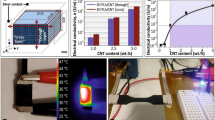Abstract
The maximum sensitivity of pH sensors is given by the Nernst equation, and its theoretical value is 59.2 mV pH−1. However, countless sensors developed and reported in the literature have their sensitivity higher than the Nernstian limit. These are called super-Nernstian sensors. To understand the causes of this behavior, the sensitivity of polyaniline thin films was studied by evaluation of an important parameter: the hydration of the film’s surface. Sensitivities were measured before and after varied heat treatments, and the sensor's parameters were associated with the amount of water lost in the process. Polyaniline thin films were fabricated by galvanostatic electrodeposition in aqueous solution, and their sensitivity was measured before and after heating of the samples. An endothermic process, typical of evaporation, was revealed by the analysis of mass loss during the heating process. A decrease in the sensitivity of the films was observed after heating process. For comparison, polyaniline thin films were also fabricated by spin coating, in the absence of water, and their sensitivity proved to be smaller than for the galvanostatically fabricated ones and it did not change significantly after the heating processes. The results indicated that the Nernst model can be adjusted using a parameter (\(1/r\)) related to the hydration of the surface of the sample, which directly affects the sensitivity of the thin films. The lowest reachable \(1/r\) value for samples containing no water is approximately 0.9. The parameter also describes the upper limits for the sensitivity of super-Nernstian sensors.





Similar content being viewed by others
Data availability
The data that support the findings of this study are available from the corresponding author upon reasonable request.
References
Lange U, Roznyatovskaya NV, Mirsky VM (2008) Conducting polymers in chemical sensors and arrays. Anal Chim Acta 614:1–26. https://doi.org/10.1016/j.aca.2008.02.068
Bergveld P (1970) Development of an ion-sensitive solid-state device for neurophysiological measurements. IEEE Trans Biomed Eng 17:70–71. https://doi.org/10.1109/TBME.1970.4502688
van der Spiegel J, Lauks I, Chan P, Babic D (1983) The extended gate chemically sensitive field effect transistor as multi-species microprobe. Sens Actuators 4:291–298. https://doi.org/10.1016/0250-6874(83)85035-5
Mello HJNPD, Heimfarth T, Mulato M (2015) Influence of the physical–chemical properties of polyaniline thin films on the final sensitivity of varied field effect sensors. Mater Chem Phys 160:257–263. https://doi.org/10.1016/j.matchemphys.2015.04.034
Mello HJNPD, Mulato M (2016) Well-established materials in microelectronic devices systems for differential-mode extended-gate field effect transistor chemical sensors. Microelectron Eng 160:73–80. https://doi.org/10.1016/j.mee.2016.03.036
Zhao R, Xu M, Wang J, Chen G (2010) A pH sensor based on the TiO2 nanotube array modified Ti electrode. Electrochim Acta 55:5647–5651. https://doi.org/10.1016/j.electacta.2010.04.102
Guerra EM, Silva GR, Mulato M (2009) Extended gate field effect transistor using V2O5 xerogel sensing membrane by sol–gel method. Solid State Sci 11:456–460. https://doi.org/10.1016/j.solidstatesciences.2008.07.014
Guidelli EJ, Guerra EM, Mulato M (2012) V2O5/WO3 mixed oxide films as pH-EGFET sensor: sequential re-usage and fabrication volume analysis. ECS J Solid State Sci Technol 1:N39–N44. https://doi.org/10.1149/2.007203jss
Chou J-C, Kwan P-K, Chen Z-J (2003) SnO2 separative structure extended gate H+$-ion sensitive field effect transistor by the sol–gel technology and the readout circuit developed by source follower. Jpn J Appl Phys 42:6790–6794. https://doi.org/10.1143/JJAP.42.6790
Chi L-L, Chou J-C, Chung W-Y, Sun T-P, Hsiung S-K (2000) Study on extended gate field effect transistor with tin oxide sensing membrane. Mater Chem Phys 63:19–23. https://doi.org/10.1016/S0254-0584(99)00184-4
Batista PD, Mulato M (2010) Polycrystalline fluorine-doped tin oxide as sensoring thin film in EGFET pH sensor. J Mater Sci 45:5478–5481. https://doi.org/10.1007/s10853-010-4603-4
Batista PD, Mulato M (2005) ZnO extended-gate field-effect transistors as pH sensors. Appl Phys Lett 87:1–3. https://doi.org/10.1063/1.2084319
Al-Hilli SM, Willander M, Öst A, Strålfors P (2007) ZnO nanorods as an intracellular sensor for pH measurements. J Appl Phys 102:084304–084304-5. https://doi.org/10.1063/1.2798582
Asif MH, Ali SMU, Nur O, Willander M, Brännmark C, Strålfors P, Englund UH, Elinder F, Danielsson B (2010) Functionalised ZnO-nanorod-based selective electrochemical sensor for intracellular glucose. Biosens Bioelectron 25:2205–2211. https://doi.org/10.1016/j.bios.2010.02.025
Alcarás JR, Mello HJNPD, Mulato M (2015) Polyaniline protonation and deprotonation process as the main mechanism for ionic field effect sensors. Org Bioelectron Process Appl 1795:41–46. https://doi.org/10.1557/opl.2015.674
Mello HJNPD, Mulato M (2018) Effect of aniline monomer concentration on PANI electropolymerization process and its influence for applications in chemical sensors. Synth Met 239:66–70. https://doi.org/10.1016/j.synthmet.2018.02.008
Mello HJNPD, Mulato M (2018) Influence of galvanostatic electrodeposition parameters on the structure-property relationships of polyaniline thin films and their use as potentiometric and optical pH sensors. Thin Solid Films 656:14–21. https://doi.org/10.1016/j.tsf.2018.04.022
Mello HJNPD, Mulato M (2018) PANI/PPY blend thin films electrodeposited for use in EGFET sensors. J Appl Polym Sci 135:46625–46632. https://doi.org/10.1002/app.46625
Bergveld P (2003) Thirty years of ISFETOLOGY: what happened in the past 30 years and what may happen in the next 30 years. Sens Actuators B Chem 88:1–20. https://doi.org/10.1016/S0925-4005(02)00301-5
van Hal REG, Eijkel JCT, Bergveld P (1996) A general model to describe the electrostatic potential at electrolyte oxide interfaces. Adv Colloid Interface Sci 69:31–62. https://doi.org/10.1016/S0001-8686(96)00307-7
Kaisti M (2017) Detection principles of biological and chemical FET sensors. Biosens Bioelectron 98:437–448. https://doi.org/10.1016/j.bios.2017.07.010
Das A, Ko DH, Chen C-H, Chang L-B, Lai C-S, Chu F-C, Chow L, Lin R-M (2014) Highly sensitive palladium oxide thin film extended gate FETs as pH sensor. Sens Actuators B Chem 205:199–205. https://doi.org/10.1016/j.snb.2014.08.057
Chung H-J, Sulkin MS, Kim J-S, Goudeseune C, Chao H-Y, Song JW, Yang SY, Hsu Y-Y, Ghaffari R, Efimov IR, Rogers JA (2014) Stretchable, multiplexed pH sensors with demonstrations on rabbit and human hearts undergoing ischemia. Adv Healthc Mater 3:59–68. https://doi.org/10.1002/adhm.201300124
Singh K, Lou B-S, Her J-L, Pang S-T, Pan T-M (2019) Super Nernstian pH response and enzyme-free detection of glucose using sol-gel derived RuOx on PET flexible-based extended-gate field-effect transistor. Sens Actuators B Chem 298:126837–126846. https://doi.org/10.1016/j.snb.2019.126837
Burke LD, Whelan DP (1984) A voltammetric investigation of the charge storage reactions of hydrous iridium oxide layers. J Electroanal Chem Interfacial Electrochem 162:121–141. https://doi.org/10.1016/S0022-0728(84)80159-X
Qin Y, Kwon H-J, Howlader MMR, Deen MJ (2015) Microfabricated electrochemical pH and free chlorine sensors for water quality monitoring: recent advances and research challenges. RSC Adv 5:69086–69109. https://doi.org/10.1039/C5RA11291E
Ping Z, Nauer BGE, Neugebauer H, Theiner J, Neckel A (1997) Protonation and electrochemical redox doping processes of polyaniline in aqueous solutions: investigations using in-situ FTIR-ATR spectroscopy and a new doping system. J Chem Soc Faraday Trans 93:121–129. https://doi.org/10.1039/A604620G
He L, Jia Y, Meng F, Li M, Liu J (2009) Gas sensors for ammonia detection based on polyaniline-coated multi-wall carbon nanotubes. Mater Sci Eng B 163:76–81. https://doi.org/10.1016/j.mseb.2009.05.009
Huang J, Kaner RB (2004) A general chemical route to polyaniline nanofibers. J Am Chem Soc 126:851–855. https://doi.org/10.1021/ja0371754
Do Nascimento GM, Silva CHB, Temperini MLA (2008) Spectroscopic characterization of the structural changes of polyaniline nanofibers after heating. Polym Degrad Stab 93:291–297. https://doi.org/10.1016/j.polymdegradstab.2007.09.001
Zhang J, Liu C, Shi G (2005) Raman spectroscopic study on the structural changes of polyaniline during heating and cooling processes. J Appl Polym Sci 96:732–739. https://doi.org/10.1002/app.21520
Acknowledgements
This work was funded by Coordenação de Aperfeiçoamento de Pessoal de Nível Superior (CAPES), Fundação de Amparo à Pesquisa do Estado de São Paulo (FAPESP, 2018/24395-8, 2018/22223-5, 2017/24201-6 and 2014/24559-0) and Conselho Nacional de Desenvolvimento Científico e Tecnológico (CNPq, 305380/2015-0) Brazilian agencies.
Author information
Authors and Affiliations
Contributions
GDMM helped in conceptualization, methodology, validation, investigation, writing—original draft, visualization; HJNPDM contributed to conceptualization, investigation, supervision, writing—original draft, visualization; MCF helped in methodology, investigation; MM contributed to supervision, writing—review and editing.
Corresponding author
Ethics declarations
Conflict of interest
The authors wish to confirm that there are no known conflicts of interest associated with this publication and there has been no significant financial support for this work that could have influenced its outcome. We also confirm that the manuscript has been read and approved by all named authors.
Additional information
Handling Editor: Yaroslava Yingling.
Publisher's Note
Springer Nature remains neutral with regard to jurisdictional claims in published maps and institutional affiliations.
Rights and permissions
About this article
Cite this article
Madeira, G.D.M., N. P. Dias Mello, H.J., Faleiros, M.C. et al. Model improvement for super-Nernstian pH sensors: the effect of surface hydration. J Mater Sci 56, 2738–2747 (2021). https://doi.org/10.1007/s10853-020-05412-w
Received:
Accepted:
Published:
Issue Date:
DOI: https://doi.org/10.1007/s10853-020-05412-w




